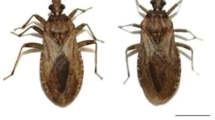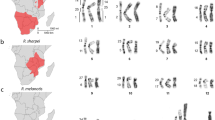Summary
-
1.
Eyprepocnemis plorans meridionalis and E. p. ornatipes have a standard acridoid complement of 2n=22+XO acrocentric chromosomes in the male. Meiosis in them is normal and the former has a higher chiasma frequency (mean Xta per cell 13.95 v. 13.33).
-
2.
Reciprocal first generation hybrids between them are described as are hybrid-derivatives produced by the back-cross (E.p.m.xE.p.o.) ♀ x E. p. o ♂. Meiosis in these is characterised by the formation of univalents, asymmetrical bivalents, multiple associations and occasionally, bridges and fragments.
-
3.
The unequal bivalents and some of the multiple associations provide clear evidence for structural hybridity of the interchange type. At least 4–6 such differences appear to obtain between the parental “sub-species” which are thus sibling-species.
-
4.
The number of different end-associations in which a given chromosome can be involved is too high to be accounted for on the basis of interchange alone. If these associations, which very frequently involve the extremely short arms, are chiasmate, then they indicate a multiplicity of end homologies in the parental forms. We, however, incline to the view that they are essentially non-homologous and non-chiasmate, owing their existence to the peculiar genotypic conditions of the hybrids coupled with their structural hybridity.
-
5.
The role of interchange hybridity in the origins of species is discussed. It is argued that where interchanges involve acrocentric chromosomes in particular, then the establishment of the change in the homozygous condition cannot be preceded by an interim balanced polymorphism.
-
6.
The structural differences described here need not have been directly involved in the differentiation of the two subspecies between which they were found. They may have been concerned in the creation of the 2 other sub-species of the species, or the 18 other species which are currently recognised in the genus.
Similar content being viewed by others
References
Callan, H. G., and H. Spurway: A study of meiosis in interracial hybrids of the newt Triturus cristatus. J. Genet. 50, 235–249 (1951).
Carson, H. L.: Genetic conditions which promote or retard the formation of species. Cold Spr. Harb. Symp. quant. Biol. 24, 87–105 (1958).
Coleman, L. C.: The cytology of some western species of Trimerotropis (Acrididae). Genetics 33, 519–528 (1948).
Darlington, C. D., and K. Mather: The elements of genetics. London: Allen & Unwin 1949.
Dirsh, V. M.: Revision of the genus Eyprepocnemis Fieber, 1853 (Orthoptera:Acridoidea). Proc. roy. Ent. Soc. Lond. B 27, 33–45 (1958).
Dobzhansky, Th.: Genetics and the origin of species, 3d Ed. Columbia: University Press 1951.
Fabergé, A. C.: Production by alpha-particles of functionally stable broken chromosome ends in maize. Genetics 44, 279–285 (1959).
Federley, H.: Das Verhalten der Chromosomen bei der Spermatogenese der Schmetterlinge Pygaera anachoreta, curtula und pigra, sowie einiger ihrer Bastarde. Z. indukt. Abstamm.- u. Vererb.-Lehre 9, 1–110 (1913); - Chromosomenanalyse der reziproken Bastarde zwischen Pygaera pigra und P. curtula sowie ihrer Rückkreuzungsbastarde. Z. Zellforsch. 12, 772–816 (1931).
Grant, V.: The architecture of the germplasm. New York: John Wiley & Sons 1964.
Helwig, E. R.: Spermatogenesis in hybrids between Circotettix verruculatus and Trimerotropis suffusa (Orthoptera:Oedipodidae). Univ. Colorado Stud. Ser. Biol. 10, 49–64 (1955).
John, B.: The chromosomes of zooparasites II. Oswaldocruzia filiformis (Nematoda:Trichostrongylidae). Chromosoma (Berl.) 9, 61–68 (1957).
—, and S. A. Henderson: Asynapsis and polyploidy in Schistocerca paranensis. Chromosoma (Berl.) 13, 111–147 (1962).
—, and G. M. Hewitt: A spontaneous interchange in Chorthippus brunneus with extensive chiasma formation in an interstitial segment. Chromosoma (Berl.) 14, 638–650 (1963).
—, and K. R. Lewis: Chromosome structure in Periplaneta americana. Heredity 15, 47–54 (1960); - The meiotic system. Protoplasmatologia. VI FI Wien: Springer 1965 (in press).
Keyl, H.-G.: Chromosomenevolution bei Chironomus II. Chromosomenumbauten und phylogenetische Beziehungen der Arten. Chromosoma (Berl.) 13, 464–514 (1962).
Lantz, L. A., and H. G. Callan: Phenotypes and spermatogenesis of interspecific hybrids between Triturus cristatus and T. marmoratus. J. Genet. 52, 165–185 (1954).
Lewis, K. R., and B. John: Chromosome Marker. London: J. and A. Churchill Ltd. 1963a; - Spontaneous interchange in Chorthippus brunneus. Chromosoma (Berl.) 14, 619–637 (1963b).
McClintock, B.: The association of non-homologous parts of chromosomes in the mid-prophase of meiosis in Zea mays. Z. Zellforsch. 19, 191–237 (1933).
Marks, E.: The cytology of Oxalis dispar (Brown). Chromosoma (Berl.) 8, 650–670 (1957).
Mather, K.: Response to selection. Cold Spr. Harb. Symp. quant. Biol. 20, 158–165 (1955).
Mayr, E.: Animal species and evolution. Oxford: University Press 1963.
Muller, H. J., and I. H. Herskowitz: Concerning the healing of chromosome ends produced by breakage in Drosophila melanogaster. Amer. Naturalist 88, 177–208 (1954).
Peto, F. H.: The cytology of intergeneric hybrids between Festuca and Lolium. J. Genet. 28, 113–156 (1933).
Price, S.: Chiasma terminalisation in a structural heterozygote in Secale. Genetics 44, 705–712 (1958).
Rees, H., and J. B. Thompson: Localisation of chromosome breakage at meiosis. Heredity 9, 399–407 (1955).
Riley, R.: The diploidisation of wheat. Heredity 15, 407–429 (1960).
—, V. Chapman, and G. Kimber: Genetic control of chromosome pairing in intergeneric hybrids with wheat. Nature (Lond.) 183, 1244–1246 (1959).
Spurway, H., and H. G. Callan: The vigour and male sterility of hybrids between the species Triturus vulgaris and T. helveticus. J. Genet. 57, 84–118 (1960).
Stebbins, G. L.: The inviability, weakness and sterility of interspecific hybrids. Advanc. Genet. 9, 147–215 (1958).
Wallace, B.: Influence of genetic systems on geographical distribution. Cold Spr. Harb. Symp. quant. Biol. 24, 193–204 (1959).
White, M. J. D.: A translocation in a wild population of grasshoppers. J. Heredity 31, 137–140 (1940; - Animal cytology and evolution. Cambridge: University Press 1954; - Cytogenetics of the grasshopper Moraba scurra I. Meiosis of interracial and interpopulation hybrids. Aust. J. Zool. 5, 285–304 (1957); - The role of chromosomal translocations in urodele evolution and speciation in the light of work on grasshoppers. Amer. Naturalist 95, 315–321 (1961).
—, and F. H. W. Morley: Effects of perioentric rearrangements on recombination in grasshopper chromosomes. Genetics 40, 604–619 (1955).
Author information
Authors and Affiliations
Additional information
We offer this paper with respect and good wishes to Prof. Hans Bauer on the occasion of his sixtieth birthday.
Rights and permissions
About this article
Cite this article
John, B., Lewis, K.R. Genetic speciation in the grasshopper Eyprepocnemis plorans. Chromosoma 16, 308–344 (1965). https://doi.org/10.1007/BF00325996
Received:
Issue Date:
DOI: https://doi.org/10.1007/BF00325996




